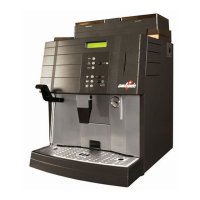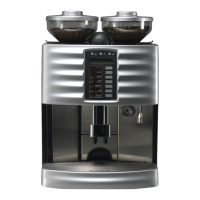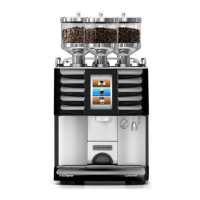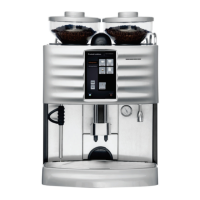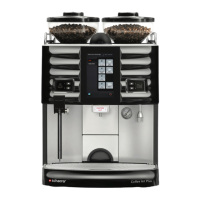Chapter 3 Functional descriptions
SMSO-2-02.03- 15.07.03 83
To serve a cappuccino only milk foam is prepared. For this product only the steam valve for the milk foam and
the milk foam pipe are involved in this process.
If white coffee is prepared with 100% milk only, then only the steam valve for milk and the milk pipe will be
involved in the process.
3.4.8 Milk / milk foam (cappuccino or milk coffee)
Product serving:
Requirements:
Notes
A cup of cappuccino coffee.
Machine in operation, heated up, programmed to automatically serve cappuccino (milk foam).
Refrigerator operational, milk container filled, refrigerator temperature 3
o
C – 5
o
C (=optimum
temperature)
The description below contains only the processes involved in the process of foaming the milk. The full
process of steam generation and coffee outlet operations is not described in detail here (see sections
entitled “Brewing system (coffee) and “Steam system (milk drinks)”). See the section entitled “Compo-
nents” in this chapter for detailed functional descriptions of individual components (e.g. pump with by-
pass).
Milk / milk foam
metering:
The quantity of the milk foam or the mixing ratio of coffee and milk is specified by the programming
system.
The sequence of product dispensing when making a cappuccino is as follows: Milk foam before the
coffee
The sequence of product dispensing for white coffee or milk coffee:
100% milk: Milk and coffee at the same time
50% milk and 50% milk foam: Milk/ Milk foam before the coffee
0% milk and 100% milk foam: Milk before the coffee
We do not recommend that you use interim values for the mixing ratio (20% / 80%, etc.) because
the amounts would be too small to make a noticeable difference to the quality of the white coffee, or
they may not even dispense at all.
Process
step
Control system (electronic/electrical) Hydraulic system
Product selection
1 The “white coffee” button is pressed.
The signal from the button panel reaches the unit control system;
the program analyses the command and starts the product dis-
pensing operation. (Programming 50 % milk and 50 % milk foam)
Milk foam outlet
2 Steam outlet valves open, (power transistors connect
through).
Lifting magnet on ventilation valve switches on (power tran-
sistor connects through)
Solenoid valves open and steam flows through the injector noz-
zles into the foamer head. The foamer head is pre-heated. *)
The ventilation valve opens and prevents milk from being sucked
up while the foamer head is being heated.
3 Lifting magnet on ventilation valve switches off Ventilation valve closes after approximately two seconds of pre-
heating time.
4 Due to the under-pressure in the injector nozzle, milk is now
sucked through the milk and milk foamer pipe from the refrigera-
tor. The milk is heated and foamed. The foaming operation is
intensified because there is an air valve in the milk foam pipe from
the refrigerator, through which air mixes with the milk.
The pressure in the steam generator goes down….
See “steam output (milk drinks)” for heating the steam generator and topping up the steam generator
Milk foam dispensing operation ends.
For programmed quantity of milk or milk foam, just before the
outlet time has expired (= a few millilitres), the following oc-
curs:
5 Lifting magnet on ventilation valve switches on (power transistor
connects through)
The lifting magnet opens the ventilation valve. The pipes to the
foamer head are sucked empty through the steam output from the
injector nozzle.
6 Solenoid valves switch off
Steam outlet operation
Ventilation valve
The milk outlet operation stops
The ventilation valve closes the milk and milk foam pipe; the milk
that has been sucked up as far as the ventilation valve flows back
into the milk container.
Coffee discharge (see “Brewing system (Coffee)”
7 Depending on the type and quantity programmed the coffee
discharge process may differ.
Another serving of milk.
Steps 1 – 7 are repeated
For a longer period with no serving of milk (other products served, or no products served at all)
The milk pipes need to be rinsed approximately 2 minutes after
the most recent product serving.
The rinse process is described in the section entitled “Rinsing the
milk pipes”.
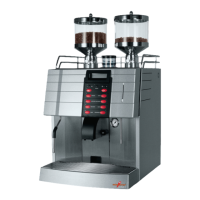
